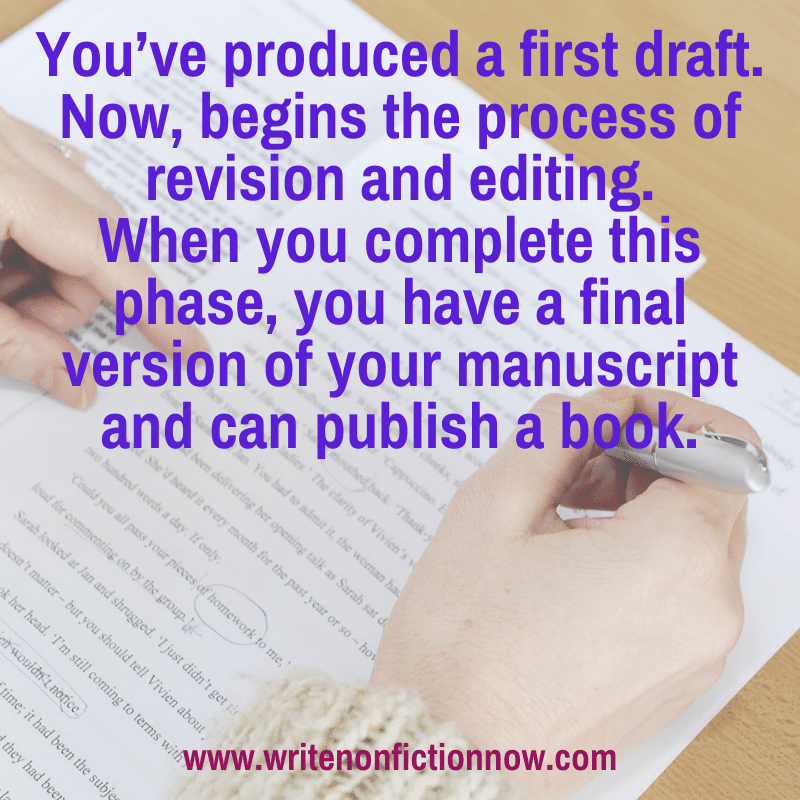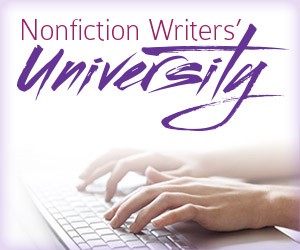Wednesday, December 2, 2020
 November creates a whirlwind of writing. Many writers participate in 30-day book-writing events, like the Write Nonfiction in November Challenge. Maybe you, too, spent an entire month composing a manuscript as fast as you could. However, when November comes to an end, even if you’ve typed “The End,” your manuscript is not done. You’ve produced a first draft. Now, in December, begins the process of revision and editing so you can complete a final version of your manuscript.
November creates a whirlwind of writing. Many writers participate in 30-day book-writing events, like the Write Nonfiction in November Challenge. Maybe you, too, spent an entire month composing a manuscript as fast as you could. However, when November comes to an end, even if you’ve typed “The End,” your manuscript is not done. You’ve produced a first draft. Now, in December, begins the process of revision and editing so you can complete a final version of your manuscript.
And that’s your nonfiction writing challenge for December: revise and edit your manuscript.
The Difference Between Revision and Editing
Before I give you the details of how to complete this challenge, it’s essential to know the difference between revision and editing.
When you revise your manuscript, you re-examine what you’ve written and make alterations to the document. This could mean adding or cutting content, moving material from one place to another, or even reorganizing chapters. You might also consider different word selections, and work on sentence structure.
Revision is all about you doing whatever is necessary to get your manuscript in the best shape possible. You do this work to prepare your written material for an editor.
Editing is the process of preparing your manuscript for publication. This may sound like revision, but, typically, editing is done by a professional editor. This process is about getting a fresh set of eyes on your manuscript. And the editor you hire will then correct or modifying the manuscript as necessary.
The editor may ask you questions or request changes. In fact, the editing process is a collaborative one that may require several “rounds” before you and the editor decide your first draft has been transformed into a final version.
What Type of Editor to Hire
Some writers revise and edit their manuscripts. And you will save money if you do both of these tasks before you hire an editor.
But hiring a professional editor when you’ve done all you can do to improve the manuscript is the difference between a professional end product and an amateur one. So, do hire an editor!
Hiring an editor can seem confusing because there are many types. Nonfiction writers typically need two: a developmental editor or substantive editor and a line editor.
The Editing Process
The developmental edit is done first. Your developmental editor takes a big-picture view of your manuscript and makes or recommends changes to improve it. These could be additions, deletions, or re-arranging content.
Sometimes, a developmental editor works as your partner as you write. You might share one chapter at a time or the entire manuscript with this “book coach.” As Jane Friedman explains, “Developmental editing describes a sustained, collaborative partnership between author and editor, during which an idea or incomplete manuscript is transformed into a complete and cohesive book.”
A substantive editor works much like a developmental editor but does not serve as a book coach who helps you structure and write the book. Often, these terms are used interchangeably, but the substantive editor makes suggestions with an eye to how each recommendation affects the rest of the book. There may be some back and forth if the manuscript needs more than one round of substantive editing.
In my experience, when working with a traditional publisher, your book first undergoes a substantive edit. Still, it may be called a developmental edit. And some writers have hired a developmental editor before submitting the proposal and manuscript to a publishing house.
The line edit comes next. Sometimes this is called copy editing. At this stage, the editor corrects usage, grammar, punctuation, and sentence strength. The editor may also look for inconsistencies of any type, like in subheadings, bullet lists, or word choice.
You will need a proofreader when editing is done. Keep in mind that it’s best to use three different professionals for these three different jobs. However, many editors do a great job of substantive, developmental, and line editing on a project. However, a proofreader will do a better job if he or she has not read the manuscript previously. This person is your last line of defense against errors, like missing periods, misspelled words, or even accidentally deleted content.
Revise and Edit Your Manuscript
I strongly recommend that you both revise and edit your manuscript before hiring a professional editor. Not only is this a great way to become a better writer and improve your manuscript, but it will also save you money.
Editing is by far the most expensive aspect of publishing a book. Editing fees vary considerably. Some editors charge by the hour, while others charge by the page or word. The more experienced the editor, the more they charge.
However, when you hand it over to an editor, the cleaner your manuscript, the less work they will have to do to improve it. And that means you pay them less.
You can find out more about self editing here, here, here, and here.
Nonfiction Writer’s Challenge—Write Your Book
To complete this nonfiction writer’s challenge, revise and edit your book.
1. Revise the first draft of your manuscript.
Reread and make changes and corrections—multiple times. Begin with a substantive-type edit looking for big-picture issues. Examine and improve your content.
Dive into each chapter looking for redundancies, ways to condense, questions left unanswered, words that need to be defined, and places where you could add or subtract subheadings, lists, etc.
2. Edit your manuscript.
When you feel as if your manuscript’s content is sound, it’s time to edit on a line-by-line basis. Revision also means working on sentence structure, transitions, and flow as well as word choice.
As you do a line edit on the manuscript, look for smaller issues in sentences and paragraphs. How can you make your sentences stronger, improve the flow of sentences, paragraphs, and subsections, or cut words?
This is the nit-picky stage of revision. You should be looking for unnecessary words, grammar issues, consistency of terms, punctuation, and consistency in formatting.
3. Hire a professional editor.
Contact professional editors while you work on revision and self-editing. They tend to be busy, so you’ll want to obtain a commitment and get your project on an editor’s calendar.
If you have written a book, you need a professional book editor. Do not hire your old English teacher or another author.
If you have written an article, essay, proposal, or some other nonfiction form, hire an editor who has experience in that form. Your writing group is not a good choice—even in an attempt to avoid editing fees, nor are your family or friends.
Do your research. Ask for referrals from other authors.
You can find qualified editors by contacting the Editorial Freelancers Association Editors Canada, and the National Association of Freelance Writers & Editors.
Speak to the editors not just about the type of editing they do and their fees but also about the books they have edited that were published and did well. Also, ask for references. Plus, many editors will do a “test edit” of a few pages, which gives you a sense of their editing style and proficiency.
If you aren’t convinced you need to hire an editor, read this.
4. Proclaim your manuscript is done.
Don’t get stuck in a never-ending revision/self-editing loop. At some point, you have to hand your work over to someone else for feedback. And, eventually—usually, when the editor says so—you will have to decide the manuscript is done.
How do you know you’ve done all you can do to improve your manuscript? Here’s a final checklist to use before you turn your work over to an editor.
When you have completed this challenge, you are ready to publish your book.
If you missed my posts in the “How to Successfully Write a Nonfiction Book” series, you can find them below:
This post serves as the final one in the series.
Have you met the challenge to revise and edit your manuscript? Let me know in a comment below. And please share this post with other aspiring writers.
 Would you like to write and publish nonfiction work, like articles, blog posts, books, or reports…and become a successful author? Check out the Nonfiction Writers’ University. Get the basic education you need and the coaching to help you succeed as a nonfiction writer. Take advantage of monthly live educational and group coaching events. Enjoy a 30-day trial membership for only $1.
Would you like to write and publish nonfiction work, like articles, blog posts, books, or reports…and become a successful author? Check out the Nonfiction Writers’ University. Get the basic education you need and the coaching to help you succeed as a nonfiction writer. Take advantage of monthly live educational and group coaching events. Enjoy a 30-day trial membership for only $1.
Do you want a more advanced approach to your nonfiction writing education? Join the Nonfiction Writers’ University MASTERS program. Receive ongoing live Certified High Performance Coaching (personal development), Author Training, and Authorprenuership Training as well as monthly educational and group coaching events. Learn all the steps to becoming a successful—and profitable—author. Discover how (finally) to write consistently, boldly, enthusiastically, and productively. Develop the mindsets, strategies, habits of the world’s most successful writers. Click here to learn more.
Photo courtesy of Kaitlyn Baker
Nina Amir, the bestselling author of How to Blog a Book and The Author Training Manual, is a speaker, a blogger, and an author, book, blog-to-book, and high-performance coach. Known as the Inspiration to Creation Coach, she helps creative people combine their passion and purpose so they move from idea to inspired action and positively and meaningfully impact the world as writers, bloggers, authorpreneurs, and blogpreneurs. Some of Nina’s clients have sold 300,000+ copies of their books, landed deals with major publishing houses and created thriving businesses around their books. She is the founder of National Nonfiction Writing Month, National Book Blogging Month, and the Nonfiction Writers’ University. As a hybrid author she has published 19 books and had as many as four books on the Amazon Top 100 list at the same time. Her most recent book is called Creative Visualization for Writers, and tomorrow her 19th book will be released, The Write Nonfiction NOW! Guide to Creativity and Flow. Find all her books at booksbyninaamir.com or find out more about her at ninaamir.com.